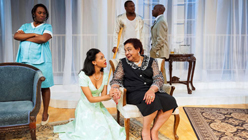When acclaimed local actor L. Peter Callender took over as artistic director of African-American Shakespeare Company a couple years ago, he said he wanted to add some modern American classics to the company’s regular offerings of William Shakespeare and holiday fairytales. His staging of Tennessee Williams’ Cat on a Hot Tin Roof with an all-black cast, inspired by a similar 2008 production on Broadway, is exactly the sort of thing he was talking about.
Although it wouldn’t make a lick of sense with Yankees, the play works perfectly well with an African-American cast. While the patriarch is a rich plantation owner, the family isn’t born of the Southern aristocracy but clawed its way up from humble beginnings. The Pulitzer Prize-winning play debuted in 1955, when the South was still very much segregated, but it doesn’t contain much in the way of references tying it to a particular period. And the way people talk isn’t the way people spoke in that time or any other; there’s a unique, ornate poetry to Williams’ dialogue that puts his plays in a world of their own.

ZZ Moor is riveting as Maggie the Cat, the beautiful but neglected wife of the family’s favored son, Brick. An ex-football hero, Brick has devoted himself to drinking full time since his best friend died, in fierce denial about the nature of their friendship.
The melodramatic Maggie is always performing, posing seductively, and kvetching nonstop in a singsong Southern accent. Her brother-in-law Gooper and his wife Mae keep popping out kids and lobbying to inherit the prosperous plantation when Big Daddy dies, but Maggie refuses to let herself be passed over. Yes, her husband drinks all day and refuses to sleep with her, hence their childlessness, but Brick is the favorite son and Maggie’s own drive and charisma are such that you find yourself rooting for her when the estate would almost certainly be better off with Gooper.




